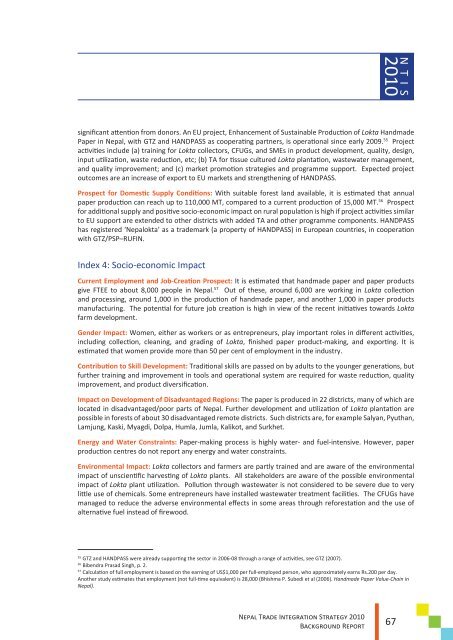Ministry of Commerce And Supplies - Enhanced Integrated ...
Ministry of Commerce And Supplies - Enhanced Integrated ...
Ministry of Commerce And Supplies - Enhanced Integrated ...
You also want an ePaper? Increase the reach of your titles
YUMPU automatically turns print PDFs into web optimized ePapers that Google loves.
N T I S2010significant attention from donors. An EU project, Enhancement <strong>of</strong> Sustainable Production <strong>of</strong> Lokta HandmadePaper in Nepal, with GTZ and HANDPASS as cooperating partners, is operational since early 2009. 55 Projectactivities include (a) training for Lokta collectors, CFUGs, and SMEs in product development, quality, design,input utilization, waste reduction, etc; (b) TA for tissue cultured Lokta plantation, wastewater management,and quality improvement; and (c) market promotion strategies and programme support. Expected projectoutcomes are an increase <strong>of</strong> export to EU markets and strengthening <strong>of</strong> HANDPASS.Prospect for Domestic Supply Conditions: With suitable forest land available, it is estimated that annualpaper production can reach up to 110,000 MT, compared to a current production <strong>of</strong> 15,000 MT. 56 Prospectfor additional supply and positive socio-economic impact on rural population is high if project activities similarto EU support are extended to other districts with added TA and other programme components. HANDPASShas registered ‘Nepalokta’ as a trademark (a property <strong>of</strong> HANDPASS) in European countries, in cooperationwith GTZ/PSP–RUFIN.Index 4: Socio-economic ImpactCurrent Employment and Job-Creation Prospect: It is estimated that handmade paper and paper productsgive FTEE to about 8,000 people in Nepal. 57 Out <strong>of</strong> these, around 6,000 are working in Lokta collectionand processing, around 1,000 in the production <strong>of</strong> handmade paper, and another 1,000 in paper productsmanufacturing. The potential for future job creation is high in view <strong>of</strong> the recent initiatives towards Loktafarm development.Gender Impact: Women, either as workers or as entrepreneurs, play important roles in different activities,including collection, cleaning, and grading <strong>of</strong> Lokta, finished paper product-making, and exporting. It isestimated that women provide more than 50 per cent <strong>of</strong> employment in the industry.Contribution to Skill Development: Traditional skills are passed on by adults to the younger generations, butfurther training and improvement in tools and operational system are required for waste reduction, qualityimprovement, and product diversification.Impact on Development <strong>of</strong> Disadvantaged Regions: The paper is produced in 22 districts, many <strong>of</strong> which arelocated in disadvantaged/poor parts <strong>of</strong> Nepal. Further development and utilization <strong>of</strong> Lokta plantation arepossible in forests <strong>of</strong> about 30 disadvantaged remote districts. Such districts are, for example Salyan, Pyuthan,Lamjung, Kaski, Myagdi, Dolpa, Humla, Jumla, Kalikot, and Surkhet.Energy and Water Constraints: Paper-making process is highly water- and fuel-intensive. However, paperproduction centres do not report any energy and water constraints.Environmental Impact: Lokta collectors and farmers are partly trained and are aware <strong>of</strong> the environmentalimpact <strong>of</strong> unscientific harvesting <strong>of</strong> Lokta plants. All stakeholders are aware <strong>of</strong> the possible environmentalimpact <strong>of</strong> Lokta plant utilization. Pollution through wastewater is not considered to be severe due to verylittle use <strong>of</strong> chemicals. Some entrepreneurs have installed wastewater treatment facilities. The CFUGs havemanaged to reduce the adverse environmental effects in some areas through reforestation and the use <strong>of</strong>alternative fuel instead <strong>of</strong> firewood.55GTZ and HANDPASS were already supporting the sector in 2006-08 through a range <strong>of</strong> activities, see GTZ (2007).56Bibendra Prasad Singh, p. 2.57Calculation <strong>of</strong> full employment is based on the earning <strong>of</strong> US$1,000 per full-employed person, who approximately earns Rs.200 per day.Another study estimates that employment (not full-time equivalent) is 28,000 (Bhishma P. Subedi et al (2006). Handmade Paper Value-Chain inNepal).NEPAL TRADE INTEGRATION STRATEGY 2010BACKGROUND REPORT67
















